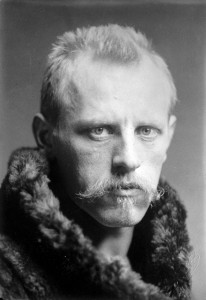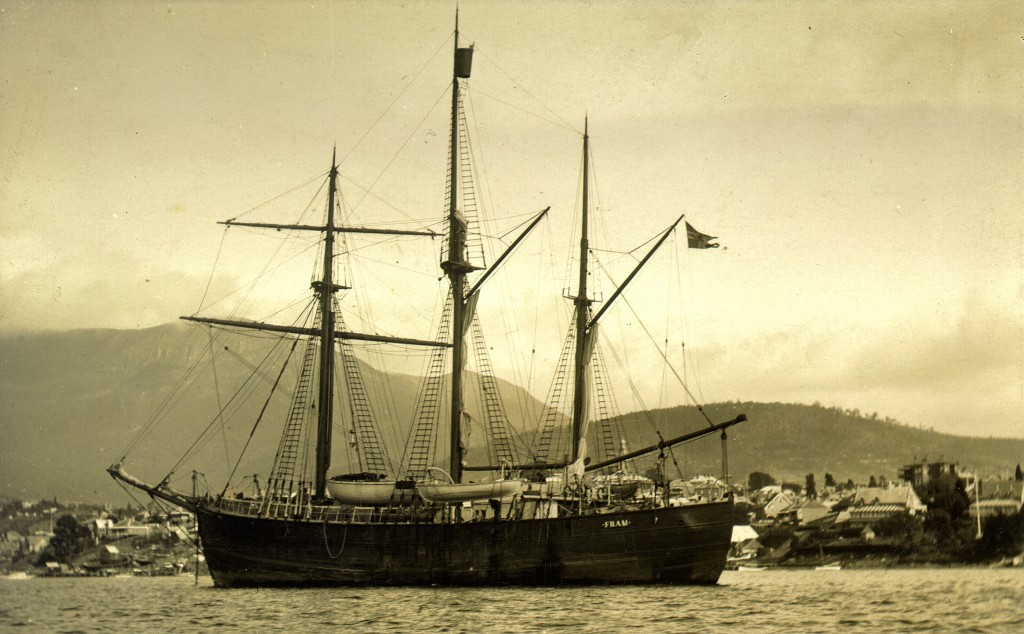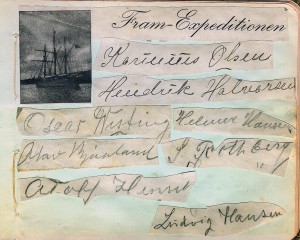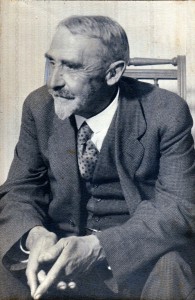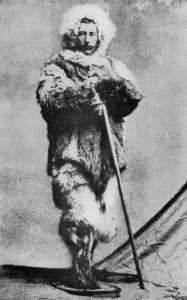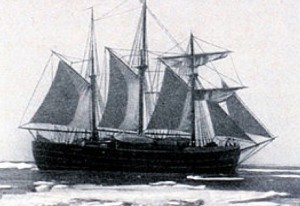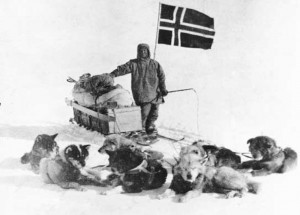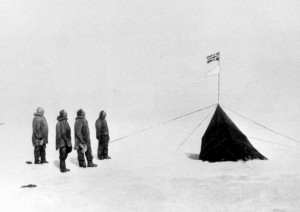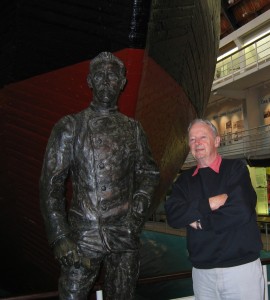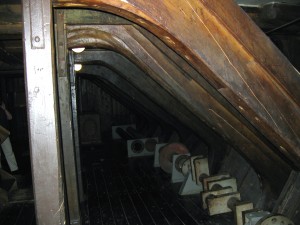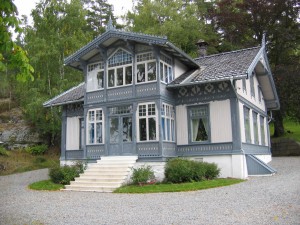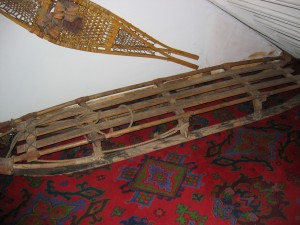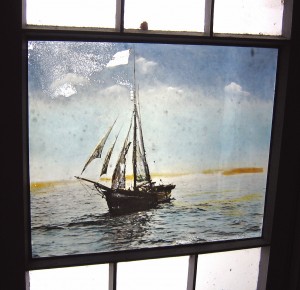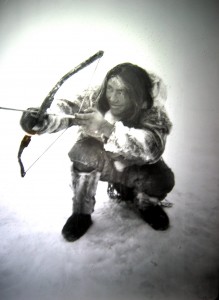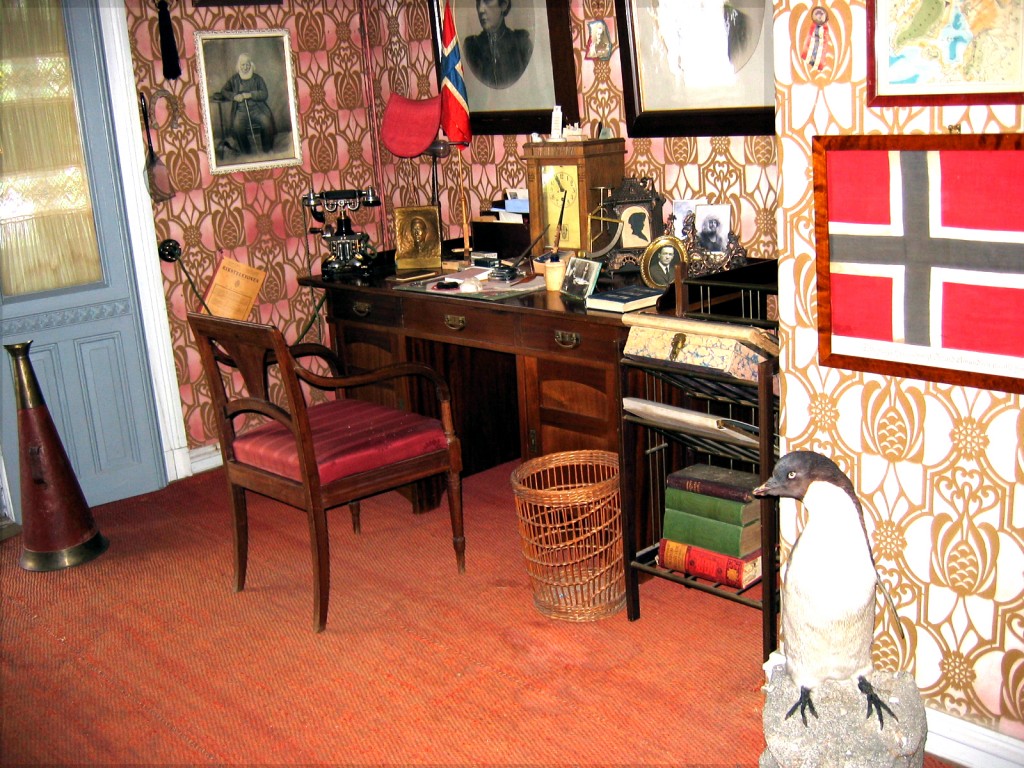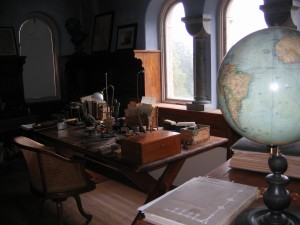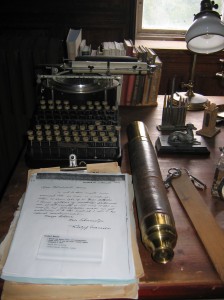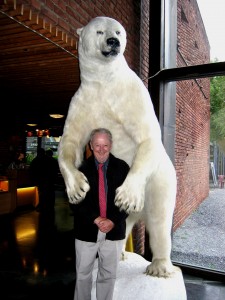FOOTSTEPS IN THE SNOW (Article first published in the Sydney Morning Herald’s Good Weekend magazine, 21 May 2005)
A family brush with polar fame in Hobart in 1912 led journalist and Antarctic historian Tim Bowden on a personal pilgrimage to Norway to live out a boyhood dream.
In the early autumn of 1912, a chunky, three-masted wooden schooner, Fram, slipped into the Derwent Estuary, near Hobart, and dropped anchor without making any formal contact with harbour authorities.
On board was the Antarctic explorer Roald Amundsen and his Norwegian companions who had just won the race to be the first to reach the South Pole.
This was an enormous news story, with the world agog to hear whether Amundsen, or the British expedition led by Captain Robert Falcon Scott, had conquered the pole.
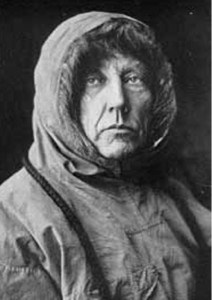
Roald Amundsen kept his South Pole plans secret from His mentor Fridtjof Nansen, who owned the schooner Fram.
Leaving Fram anchored out in the stream, Amundsen rowed himself ashore, alone. Fending off reporters’ questions, the dour adventurer booked in at Hadley’s Orient Hotel and wrote in his diary: Treated as a tramp – my peaked cap and blue sweater – given a miserable little room. Then I cabled the King… The day passed quietly, except for reporters, who were insistent, but without result…
Amundsen’s telegram to King Haakon of Norway was entrusted to my grandfather, Frank Bowden, then Manager for Telegraphs at the Hobart Post Office.
So for several days my grandfather was the only person, other than the ship’s company, to share the secret. My father, John Bowden, remembers Frank Bowden saying that Amundsen was most formal in his dealings with him. There were good reasons for that.
Amundsen sent several other telegrams that day, 7 April 1912.
One was to the renowned fellow Norwegian polar explorer, Fridtjof Nansen, who had Fram specially designed to freeze into the Arctic pack ice and attempted to drift over the North Pole from 1893 to 1896. Nansen had made his singular polar ship available to Amundsen – but controversially not for his Antarctic venture. Of which more in a moment. Another telegram was sent in code to his brother Leon, who was managing his affairs in Norway.
Leon Amundsen instructed his brother to cable an exclusive report to The Daily Chronicle, in London, which he did the following day. By 10 pm the momentous news had bounced back on the wire services, and a storm of publicity erupted around Roald Amundsen and Fram. (History does not relate whether Hadleys Orient Hotel gave their distinguished guest a better room.) With the secret well and truly out, at least the doughty little ship was permitted to berth in the port of Hobart.
- A page from my Aunt Noras autograph book in which she secured the signatures of some of Frams crew including three of the five from the polar party. They were Oscar Wilsting, Helmer Hansen (who interestingly spelt his name with with one ‘s’ when officially it was Hanssen), and Olav Bjarland. She was 12 years old at the time. Hanssen had been with Amundsen on his first ever navigation of the North-West Passage from 1903.
My aunt Nora, then aged twelve, joined other curious Tasmanians and went on board Fram. There she managed to get the signatures of seven expedition members, which she later cut out and pasted in a small autograph book. (She managed to score three of the five men who had actually skied to the South Pole, Oscar Wisting, Helmer Hanssen and Olav Bjaarland. The other two were Sverre Hassel and Amundsen himself who was not signing autographs that day – or at any other time, probably.)
Fram was in Hobart for thirteen days. When she left on 20 March, bound for Buenos Aires, Scott’s disastrous polar retreat was about to stall. The gallant Captain Oates had already tottered out of the tent on his frostbitten feet three days before, following his much-quoted exit line: ‘I am just going outside and maybe some time’. But Scott himself was unable to walk much further on his own frost-bitten and gangrenous feet, and on 21 March the four remaining men pitched their last camp just eleven miles from One Ton Depot, where food and fuel awaited them. They never left it.
NANSEN AND MRS SCOTT
Strangely enough, Amundsen’s triumphant telegram to Nansen was received by his famous mentor with mixed feelings. Nansen, as it transpired, was having an intimate correspondence with Scott’s wife, Katherine, when his Norwegian rival won the race. As Roland Huntford reveals in Scott And Amundsen, his controversial biography of these two men, Nansen was in the act of writing a passionate letter to Katherine when he was called to the telephone to have Amundsen’s telegram read to him. He returned to his letter to Scott’s wife, in an ‘unhappy and uneasy’ frame of mind and wrote: Oh, why are there so many difficulties in the world and why is life so complicated? [Amundsen] has evidently sailed very fast, and my old ship has done well – but I still wish that Scott had come first. Yes, life is very complicated indeed!
That was putting it mildly. Nansen, the great Norwegian nationalist who had used his fame as a scientist, polar explorer and diplomat to help obtain Norway’s independence from Sweden in 1905, could hardly barrack publicly for Scott. Nansen and Katharine Scott’s friendship cooled when the news of Amundsen’s polar success was flashed around the world. Before long Nansen was writing to Katherine – who not surprisingly detested Amundsen – defending his fellow Norwegian and saying what a ‘fine and noble’ fellow he was.
Amundsen deserved his success. His polar credentials were impressive. They began when he volunteered to join the Belgian Antarctic Expedition in 1897 as second mate. The Belgica was the first scientifically equipped ship to land researchers on the islands of the Antarctic Peninsula. Early in 1898 Amundsen became the first man to ski on the Antarctic Continent, on Two Hummock Island. Because Belgica became trapped in the ice, Amundsen unwittingly took part in the first ever wintering in Antarctica.
As a young man he was inspired to become a polar explorer after Nansen’s attempt (in the purpose-built Fram) to reach the North Pole in during his epic three-year expedition from 1893. Amundsen managed to finance his own private expedition to attempt to be the first to navigate the fabled North West Passage. This quest which had already claimed the lives of Sir John Franklin and 128 of his men when the former governor or Tasmania had attempted the same feat in 1845. Franklin set out with two big ships, Erebus and Terror, both of which disappeared without trace. Amundsen’s approach was different. Combining exploration with science – he hoped to locate the North Magnetic Pole – his tiny 47-ton sloop Gjoa would carry only eight men. On board were twelve Eskimo dogs, which Amundsen believed were the key to successful polar exploration.
During his three-year expedition he not only successfully traversed the North West Passage in his shallow-draft sloop (his achievement was symbolic because he also proved the fabled passage was unsuitable for commercial navigation) but lived with and studied how the local Inuit people coped with their extreme environment. He noted how they drove their dogs, and how coating wooden sledge runners with ice could overcome friction in extremely low temperatures. Amundsen learned how to build an igloo as an emergency shelter, and acquired Eskimo fur clothing and boots, which were far superior to wool or any European clothing.
Sponsorship was as important to private expeditions then, as it is now. Gjoa had slipped away in the night at the start of the voyage. ‘Well boys, we’re clear of the creditors’, Amundsen said to his crew as he broke out a bottle of rum to celebrate their departure.
Although he had conquered the North West Passage, he had to spend a third winter, frozen in the ice tantalisingly near the end of his journey off the Yukon Coast of Canada. Amundsen skied 500 miles to Eagle City, a trading outpost in Alaska, where he could communicate with the outside world. He had an exclusive contract with The Times of London, but had to send his 1000 word Morse-coded telegram collect. It cost US$755 (about US$5500 in today’s terms). Unfortunately his message was leaked to United States newspapers along the way. As a result The Times refused to honour their contract and his remarkable 1000-mile Arctic journey had been in vain. No wonder my grandfather, Frank Bowden, found Amundsen stiff and formal when he called into the Hobart Post Office, after his bruising experience in Alaska.
GOING SOUTH INSTEAD OF NORTH
In 1907 the focus of exploration was on the North Pole. The American explorer, Robert Peary, had just returned from his second attempt to reach the pole from Cape Columbia on the tip of the North American continent. Amundsen favoured the approach of his hero, Nansen, who by freezing Fram in the polar ice pack had drifted within range of the pole. Using dogs he and a companion, Hjalmar Johansen, skied to 86°14’, a record at that time. Amundsen proposed to use the same approach, but to get even closer to the pole by freezing his ship in the ice on another line of drift. Fram was the obvious ship for the job, but Nansen still had first call on her. Nansen himself was eyeing off the South Pole, but was so busy with diplomatic and scientific tasks, that he after some reluctance and hesitation told Amundsen, ‘You shall have Fram’. The two men were not close, although Nansen respected Amundsen as an accomplished explorer and a Norwegian nationalist.
The usual nightmare of fund-raising for the North Pole voyage began. This time the Norwegian government stepped in with a substantial grant and Amundsen was able to re-fit Fram and plan for the expedition. But in the first week of September 1909, both Robert Peary and his fellow American Dr F A Cook, emerged from the Arctic each claiming to have reached the North Pole. (It was unlikely that either had first-footed the pole, a controversy unresolved to this day.)
This was a terrible blow to Amundsen, who nevertheless kept on with plans for his Arctic venture. Secretly, however, he determined to take Fram south and have a crack at the South Pole. He did not tell Nansen, the Norwegian government, nor his private backers believing they would withdraw their support. Remarkably he was able to conceal his South Pole plans for a whole year of preparation, although his crew did wonder what the large prefabricated hut (to be their winter base on the Antarctic continent) was for!
Amundsen did not tell his crew of the change of plan until they were weighing anchor in Madeira, two months into their voyage. He handled this brilliantly, and won them over to a man. By leaving this bombshell until they were leaving port, he managed to keep his plans secret from the rest of the world – and in particular, Scott’s expedition. The timing was still very tight. Scott had said he should be at the pole on 22 December, 1911. Amundsen planned to beat him by three weeks.
The Norwegians made their base camp at the Bay of Whales, a region of the towering Ross Ice Shelf where an island close to the coast caused the front of the barrier to slope down to sea level. There was a risk Amundsen and his party could break away and float out to sea if the barrier ‘calved’ while they were there, but that was thought unlikely.
Amundsen’s secret weapons were skis and dogs – largely eschewed by Scott, despite much advice to the contrary. Even Nansen had advised Scott to take dogs. However both Scott and Sir Clements Markham, his backer at the Royal Geographical Society, thought that the toil of man hauling made ‘the conquest…more nobly won’. Amundsen, on the other hand as his biographer Huntford pithily put it, recoiled from the martyrdom of man hauling to which official British explorers had become addicted.
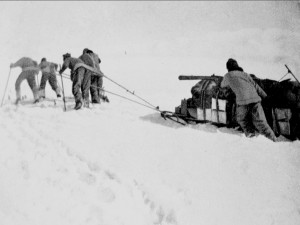
Scott chose not to use huskies, but believe it more noble to undertake the brutal tyranny of manhauling to which British explorers had become addicted.
The story of what happened is well known. Scott, putting his faith in man hauling, plugged on doggedly to the South Pole to find Amundsen’s tent already there, Norwegian flag proudly flying. At the last minute, Scott had added am extra man to his party.
His two sledges were packed with equipment and food for four men. Now there were five. Erratic planning was one of Scott’s greatest failings. It has been argued that particular change of plan alone could have been enough to doom his expedition.
Using dogs and skis and protected from the extreme cold and blizzards by their Eskimo fur clothing, Amundsen and his four companions arrived at the South Pole in sunshine and perfect conditions on the afternoon of 15 December, 1911. Amundsen wrote in his diary: I cannot say… that I stood at my life’s goal. I believe no human being has stood so diametrically opposed to the goal of his desires as I did… the North pole had attracted me since the days of my childhood, and so I found myself at the South Pole. Can anything more perverse be conceived?
Leaving a spare tent proudly flying the Norwegian flag, they headed back to the coast the way they had come. It had been a bravura performance – but one which had been carefully planned.
They arrived back at their base at The Bay of Whales on 26 January 1912 – two weeks earlier than expected. The five men and sixteen surviving dogs (their companions had been slaughtered to feed them en route to the pole) were in excellent condition, and all five of the polar party had put on weight! Those dogs were on board Fram when she arrived in Hobart with the principal dog driver, Helmer Hanssen whose signature was secured by my sub-teen Aunt Nora.
CHASING A BOYHOOD DREAM
On my study wall I have a photograph, framed in Tasmanian oyster pine, of J W Beattie’s image of Fram (it means ‘forwards’ in Norwegian) anchored in the Derwent, with Hobart and Mount Wellington in the background – given to me by my parents Peg and John Bowden in 1977 to mark my 40th birthday. My grandfather’s brush with Antarctic fame was a matter of family pride. In addition my father and I shared an interest in polar literature. At the age of 13 I had read Nansen’s Farthest North and was captivated by Nansen’s stirring narrative, who not only wrote and spoke English beautifully, but combined the rare skills of a scientist, poet and high adventurer. Farthest North was an ripping yarn for any reader, including an adolescent Tasmanian boy. It was sub-titled Being the record of a voyage of exploration of the ship Fram, 1893-1896, and of a fifteen months’ sleigh journey by Dr. Nansen and Lieut. Johansen.
Nansen was already well known for leading an expedition which made the first coast-to-coast crossing of Greenland, in 1888. But his three-year attempt to drift to within striking distance of the North Pole at the end of the nineteenth century made him seriously famous around the globe, and a household name.
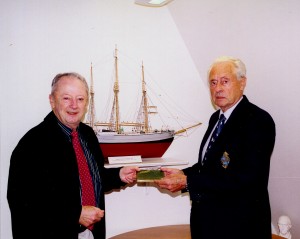
Tim Bowden presenting the Director of the Fram Museum Kare Berg, with the original autograph book of my aunt Nora Bowden in which she had pasted the signatures of some Fram's crew in Hobart.
Because of the Bowden family’s brush with Antarctic fame in Hobart in 1912, I had long wanted to visit Oslo to see Fram which I knew was housed in its own special museum. This ambition was realised in September 2004 when my wife Ros and I went to Norway, to present my Aunt Nora’s diary with its historic signatures to the Fram Museum’s director Kare Berg, who is (as you would expect in Norway, a retired sea captain!) and a photo of Fram in the Derwent Estuary that the museum did not have in its collection.
The Fram Museum, an huge ‘A’ frame building of traditional Norwegian design used to house admittedly smaller boats during the winter, was built around Fram in 1936 after the historic wooden ship was nearly lost. Her most famous captain, Otto Sverdrup, campaigned to have her preserved.
In recent times the sloop Gjoa(in which Amundsen firstconquered the North West Passage) has been added to the display, and sits outside near the wharf where visitors come to the Bygdoy peninsula to visit a cluster of museums, including the Kon-Tiki Museum, Maritime Museum, Viking Ship Museum and the Norwegian Folk Museum.
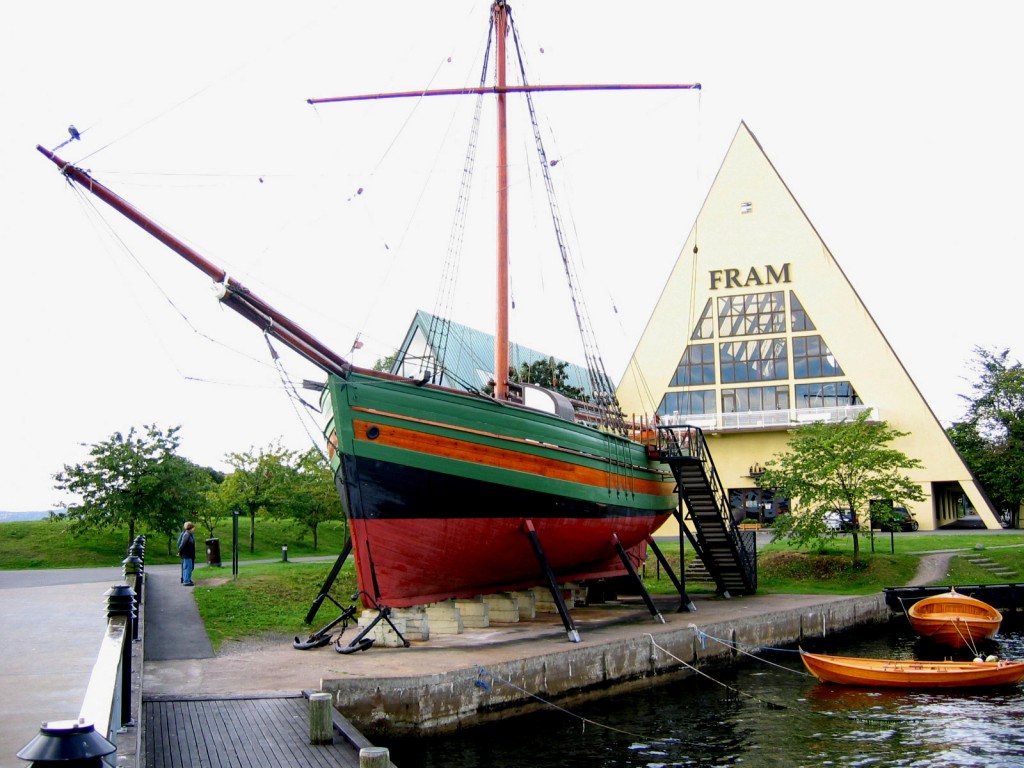
The little sloop Gjoa (which Amundsen sailed through the North-West Passage) is now on display in front of the Fram Museum in Oslo.
We spent a day happily prowling about Fram, which allows visitors full access above and below decks. The tiny cabins show the names of the captains and leaders of the three principal voyages of exploration who occupied them – the North Pole bid, an exploration of the coast of Greenland and the triumphant South Pole expedition.
I was delighted to be able to photograph the great oak ‘knee’ struts that so successfully resisted the pressures of the pack ice, and also the first diesel engine ever to be installed in such a large ship (if Fram can be so described) for the South Pole venture. When I commented to the museum’s directed Kare Berg that the Nansen’s ship was larger and more substantial than I had imagined, he commented dryly: ‘When you put a ship in a house, it looks bigger.’
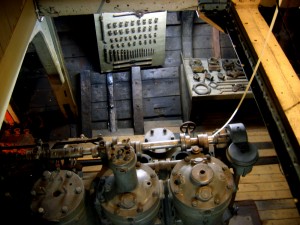
Fram had the first diesel engine ever fitted to a large vessel – installed by none other than its inventor, Mr Diesel himself.
I had asked if I could visit Nansen’s house, Polhogda, which I knew was not open to the public. As a bonus, Kare Berg took me first to Amundsen’s house, spectacularly situated on a fjord on the outskirts of Oslo, which I did not know was a private museum.
Fram was moored in front of it before Amundsen left on the Antarctic voyage. As we walked in the front door, the obliging curator pointed to a small wooden sledge stored under a steep, narrow staircase. ‘That is the sledge Amundsen took to the South Pole and back’, she said casually. I touched it reverently and took a photo.
An unusual feature of the house were some windows on which the image of tinted glass photographic plates had been transferred so that the incoming light highlighted them. One was of the famous sloop Gjoa (now seen in front of the Fram Museum) and another an Eskimo encountered on the North West Passage voyage from whom Amundsen had learned a great deal, not only about driving sledge dogs, but about fur clothing and boots necessary for survival in sub-zero temperatures.
VISIT TO NANSEN’S HOUSE
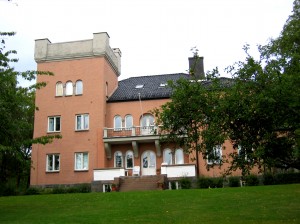
Nansen's rather grand house Polhogda is not normally open to the public as it is now a research institute. His study, in the top of the tower to the left, was shuttered and left exactly as he walked out of it before his death in 1930.
As a further surprise, Kare Berg had arranged lunch with Nansen’s granddaughter, Marit Greve, who was also the Chairman of the Fram Museum board, before we all headed for Nansen’s substantial house, built in 1900 from plans originally sketched out by him. It looks more Victorian than Norwegian, with a large tower on one side. After his death in 1930 the family donated the house to the Academy of Sciences and is now known as the Fridtjof Nansen Institute, supporting a variety of scientific research programs.
A condition of the bequest was that Nansen’s study, situated in the top of the tower, be preserved as he left it. To our great joy, Ros and I were taken there. The shutters were removed from the tower windows, and I was permitted to photograph Nansen’s study as it was when he last left it. That night I had to admit to being a truly happy man.
Nansen never went on another voyage of exploration after his North Pole attempt, but remained a figure of great influence in polar exploration for many years, and used his position, influence and diplomacy to achieve Norway’s independence from Sweden without bloodshed, by 1905. In later years he became involved with the League of Nations, particularly with the refugee crisis in Russia after the Communist revolution there. ‘The Nansen Passport’ was the name given to a certificate of identity and travel document granted to refugees.
When I first went to Antarctica with ANARE (Australian National Antarctic Research Expeditions) in 1989 I was fortunate enough to experience a run on the sea ice with husky dogs (before they were withdrawn on environmental grounds in the early 1990s). They pulled a wooden Nansen sledge, its wide runners and raw-hide bindings still in operational use late in the twentieth century, and designed by Fridtjof Nansen.*
*Those interested in the extraordinary life of this multi-talented Norwegian should read Roland Huntford’s seminal biography, simply titled Nansen. It is published by General Duckworth & Co Ltd, London, 1997. Also do not miss Huntford’s controversial biography, Scott and Amundsen, Weidenfeld, London 1993.

